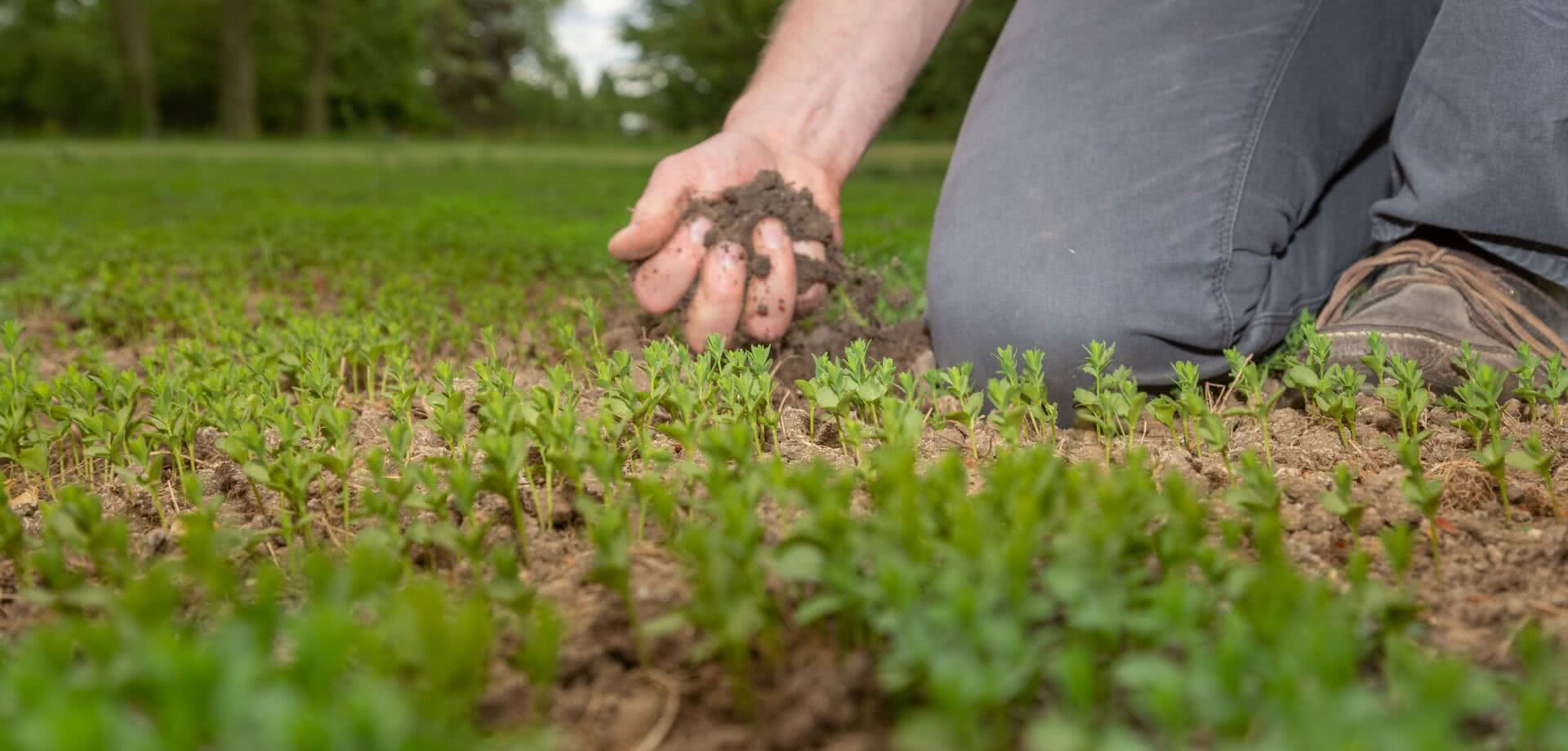
Flax growing and expertise
The cultivation of flax is deeply rooted in Western European history and culture, enriched by generations of expertise. It is the focus of farmers, entrepreneurs and designers who have been able to renew and innovate. In each era, linen reinvents itself and endures.
From field to finished product
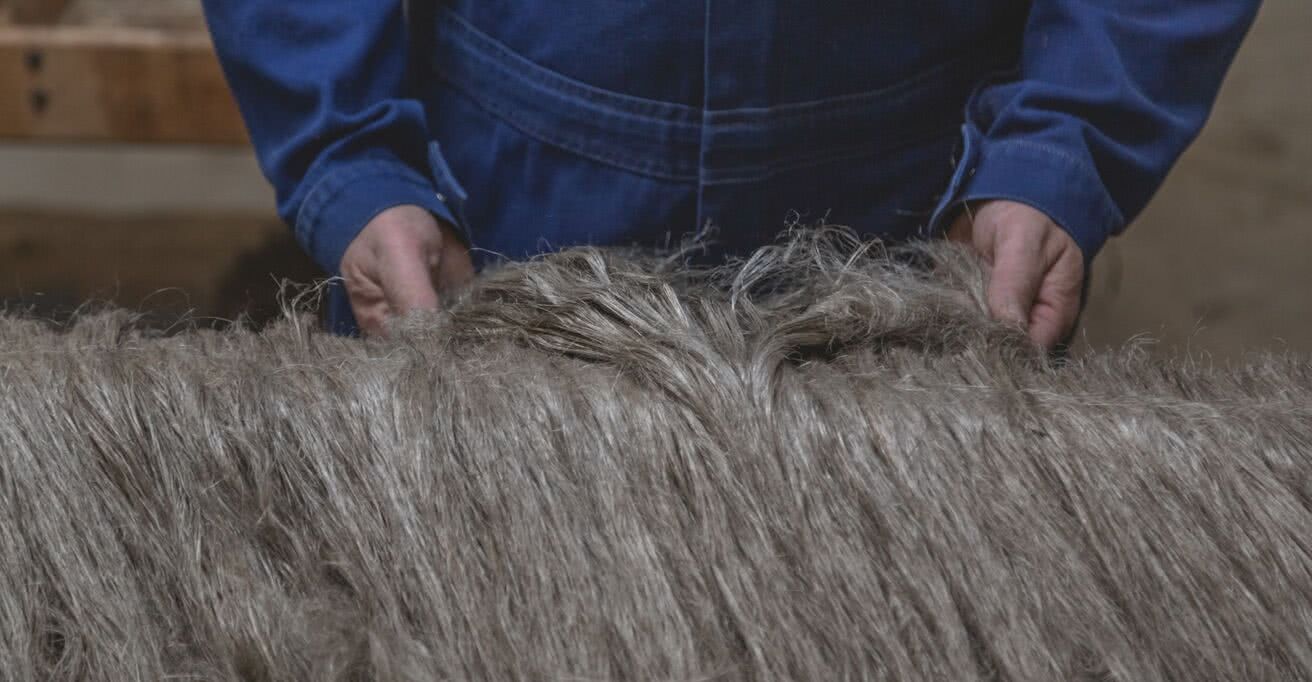 copyright Alliance P. Sagnes
copyright Alliance P. Sagnes
Flax cultivation is based on two major factors: geographic and climate-related advantages and unique expertise. At the agricultural level, the expertise passed down through the generations is best embodied by the grower-scutcher collaboration.
They serve as the geographic anchor of this eco-friendly crop that is internationally renowned and cannot be delocalised. (Western Europe - France, Belgium, and the Netherlands - is the leader in flax fibre production and accounts for three-quarters of global flax production.)
The process is powered by the work of human hands. Growers and scutchers, the workers of the plains, make all decisions jointly, and the final quality of the harvest depends on their synergy. A synergy also operates between the scutcher and spinner.
The production of flax, an agro-creative fibre from a terroir, requires a combination of human hand, ancestral expertise and mechanical strength. From the pretty blue flowers that dot the flax fields that we gaze at in wonder to the touch of the material, flax stuns the senses. Flax takes us on a technical, symbolic and artisanal journey.
The flax industry: momentum and innovation for sustainable development
The flax industry brings together all stakeholders in this value chain of excellence, creating magic that doesn’t exist anywhere else in the world. From fibre production to making yarn and fabric with high added value, the European flax production chain feeds into and is enhanced by an abundance of innovations, in particular the development of new textile production processes for knitting and innovative technical applications:
- Linen knits help to reduce creasing, seen in collections at all levels of the market and for all seasons.
- Fibre blends, or hybridisation, allow for complementarity between fibre performance and use.
- Various washed linen techniques > colour > the democratisation of linen
- Outdoor or water-repellent linen.
Linen adds value in the form of expertise, creativity, and innovation.

The stages of flax cultivation
Grown in rotation, every 7 years on average on the same plot, and with low nitrogen needs, flax-linen helps provided optimum soil quality and is an excellent head of rotation.
sowing
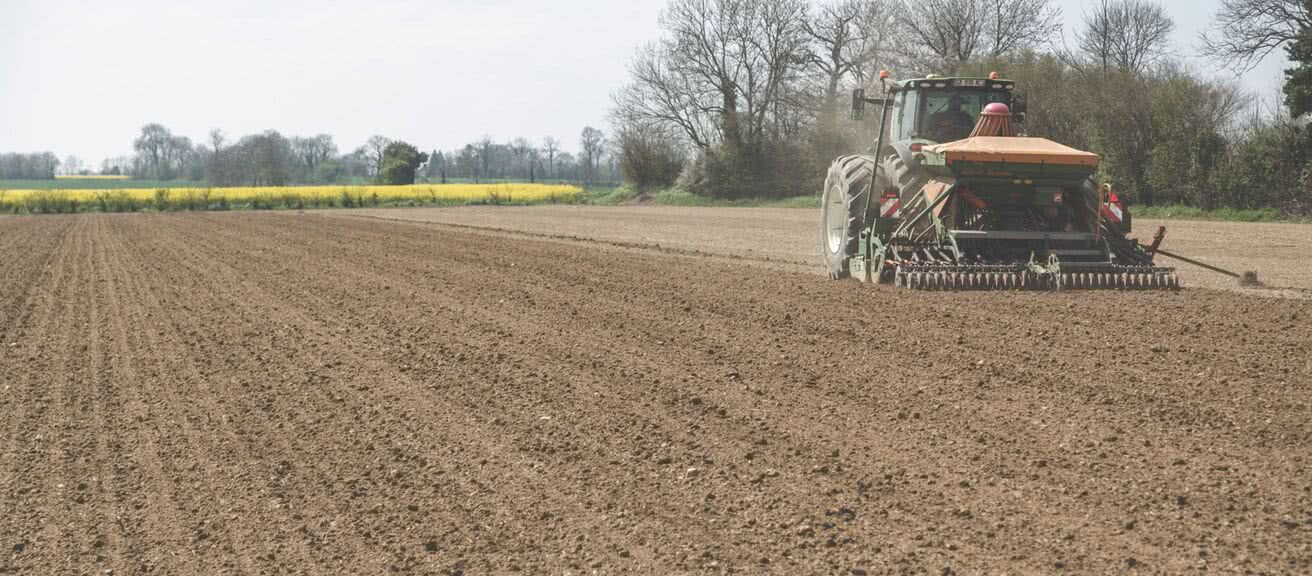
1 • Sowing
Sowing takes place in March or April, depending on the region. Seeds are planted at a depth of 1 cm or 2 cm, and the plants reach maturity after 100 days. There are 80 to 100 leaves on the base of each plant. Flowering occurs in June, and the plants reach a height of approximately 100 cm. They say, “it’s June that makes linen” and you need to know how to take advantage of it! Because the lifespan of a flower is only a few hours: it blooms in the morning and fades at midday.
blooming

2 • Flax blooming
Flax flowers in June. The plants reach a height of approximately 100 cm. The flowers only live for several hours, blooming in the morning and wilting during the day.
pulling

3 • Flax pulling
Pulling starts in July, when the stems have lost their leaves along a third of their height from the soil. Flax is not cut, but rather pulled, to preserve the full length of the stems. The plants are then placed on the ground in swaths or windrows (continuous rows one-metre-wide). After pulling, the long roots remaining in the soil serve as fertiliser, making flax the ideal first crop in a cycle of rotation.
retting
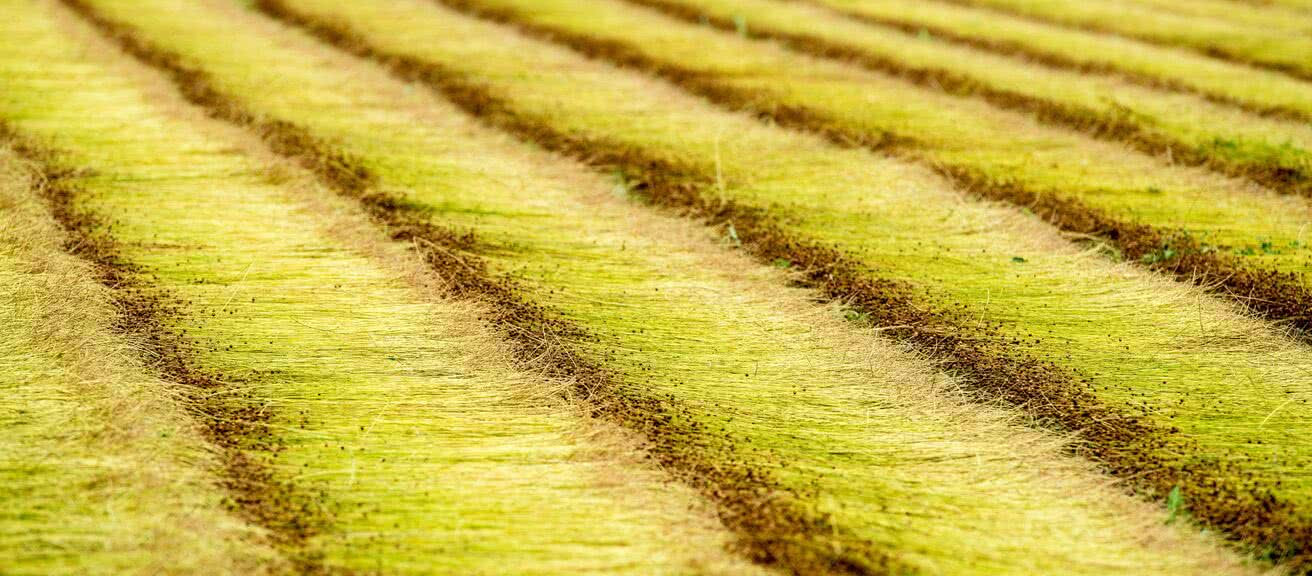
4 • Flax retting
Retting is the first 100% natural processing phase for turning the plant into fibre. Precipitation, morning dew, and sunshine help microorganisms in the soil break down the pectose, which binds the textile fibres to the woody part of the stem. The retting phase lasts from July to September. To promote even retting, the flax is turned halfway. At the end of this stage, flax is collected into bales.
scutching

5 • Flax fibre scutching
Flax fibres are contained in the outer layers of the stem. In order for them to be used, they must be extracted and separated from the wood present in the stem (shives). Scutching is a mechanical process which can be performed anytime during the year. The entire plant is valued, and nothing is wasted: all fibres, long and short, and all derivatives (seeds and shives) are reused, for example as animal bedding.
hackling
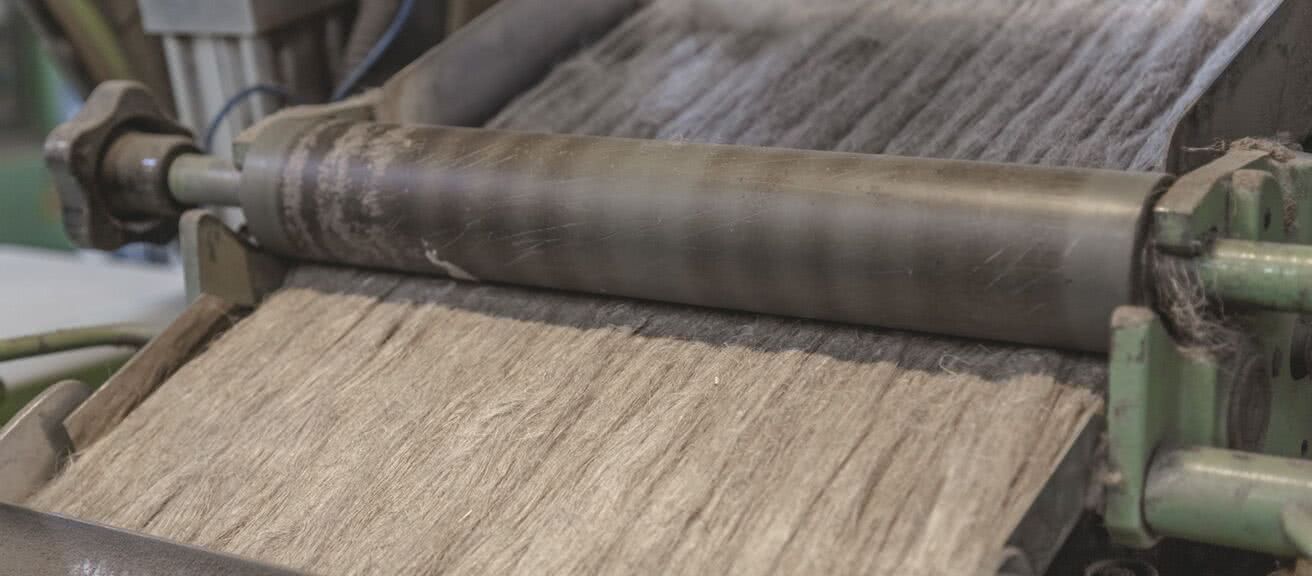
6 • Flax fibre hackling
This operation is performed more and more frequently by scutchers. Thecombed fibre is parallelised, calibrated, and stretched to form soft, lustrous ribbons.
Preparing

7 • Preparing flax for spinning
During this stage, hackled flax from different batches of fibres, grown on different fields and in different regions, and during different years, are blended together: this assembly is comparable to the methods used to produce champagne and cognac, as the properties of each batch are combined to create a homogeneous yarn that is consistent over time. Quality standards that may lead to each strand containing flax from up to 32 different batches!
spinning
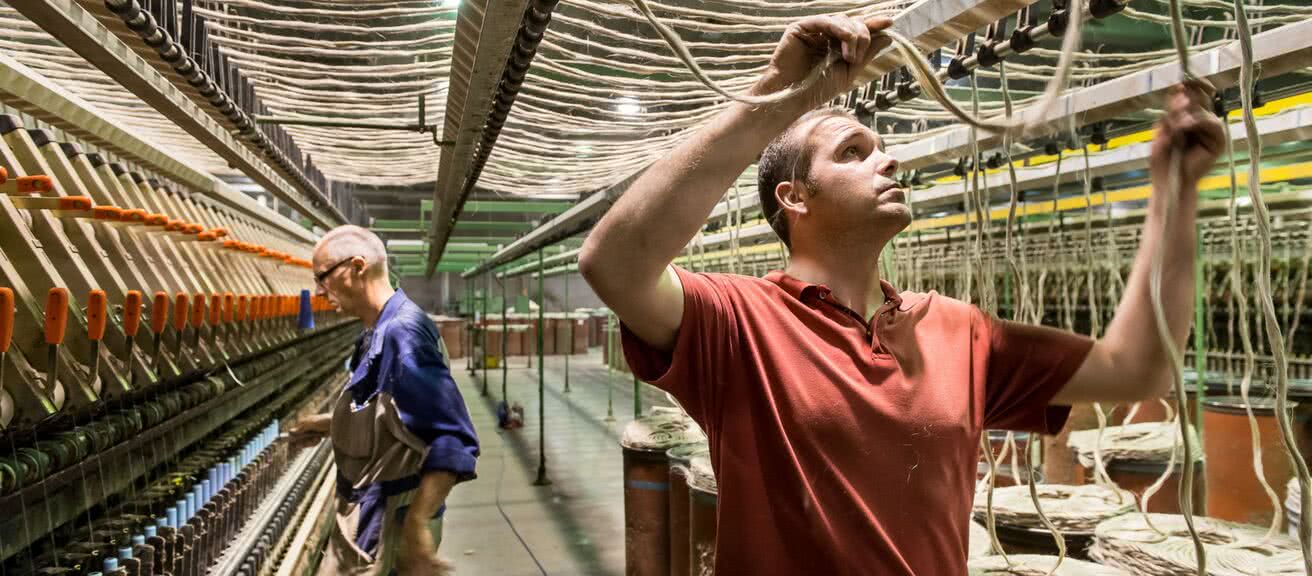
8 • Flax spinning
Spinning transforms the flax rovings into yarn by applying a twist, with a differentiating factor, the assembly. Just like with wine or champagne, it all comes down to the blending! In order to always ensure identical yarn quality, it is necessary to source different batches from different fields, different regions, and different years; through unique and invaluable expertise. Spinning techniques vary depending on the yarn to be produced.
- “Wet” spinning, which involves immersing the fibres in water heated to 60°C, promotes the gliding of the fibres and works well for yarn used in clothing or household linen.
- “Dry” spinning creates more rustic and thicker yarn for use in furniture, cord making etc.
A variety of standards allows for a wide range of yarn, sorted by metric count (Nm). It is defined as the number of kilometres of yarn per kilogram. The higher the number, the finer the yarn on a scale from Nm1 to Nm60, sometimes even reaching Nm100.
weaving
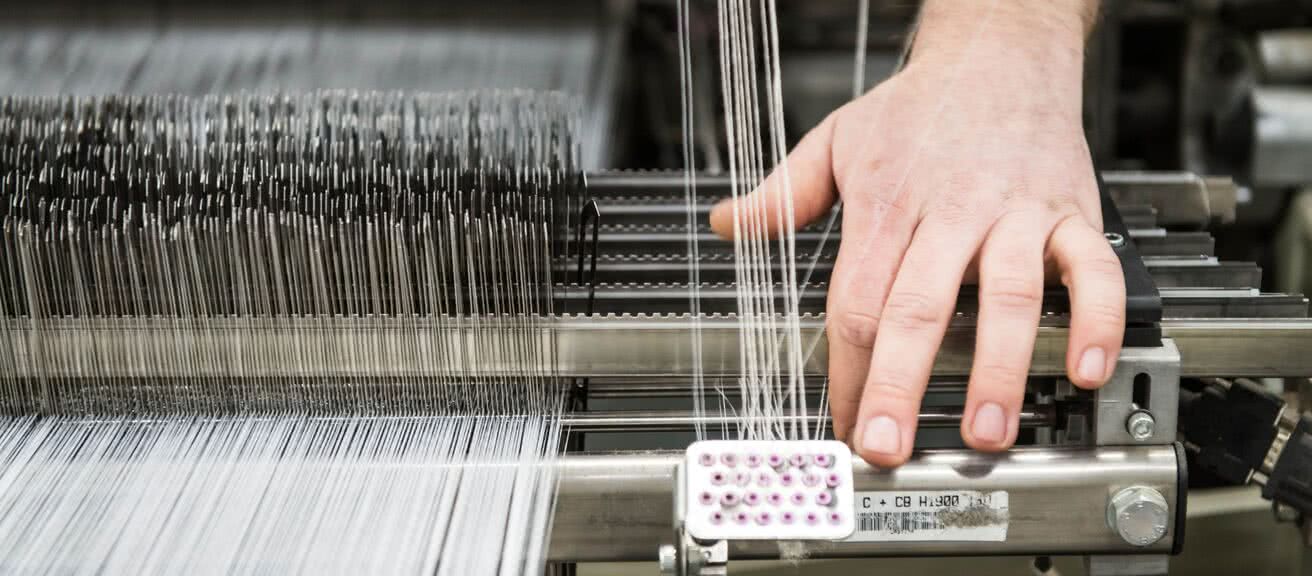
9 • Weaving linen
Weaving consists of interweaving warp threads (which run lengthwise) and weft threads (width-wise) to create a fabric. Different weaving methods can be used to create different fabrics in terms of both appearance and texture. A variety of weaving methods, adapted for different thicknesses and effects, have given rise to creative permutations of fabric for use in clothing, household linens and furnishings.
knitting

10 • Knitting linen
Knitting gives linen yarns greater flexibility, elasticity and crease-resistance. Knit fabric or jersey, made on circular knitting machines and then cut and sewn, is used predominantly to make T-shirts, tops, sweatshirts, etc. Knitwear is made on flat knitting machines that can create pieces that are shaped, ready to assemble, or seamless knits in 3D.
The uses of flax-linen
Agro-creative flax-linen can be found in all three main areas of design: 60% by volume is used in fashion, 30% in lifestyle, and interior decoration and 10% in technical applications.

Linen in fashion
The textile industry is the largest market for flax. Numerous studies commissioned by the Alliance by the fashion search engine Tagwalk confirm that the fashion sector is increasing its use of linen. For several seasons now, the luxury segment has been regularly including linen in its women’s and men’s collections.
Designers such as Jacquemus and the house of Dior have led the way. Other great names in fashion use the material in hybridised form, for example Fendi mixed with leather and lace. And others, like Chloé, use it in accessories. All ready-to-wear brands are putting linen in the spotlight in summer and winter collections alike.
Learn more
Linen in decor
Just like linen jersey which opened up new markets for fashion, washed linen is being used more and more frequently to make household linens, bed sets, tablecloths, tea towels, etc.
The fibre’s high absorption allows for a wide range of colours, from pink to grey via saffron yellow.
Learn more
Textiles and tech
Longboards, skis, bicycle helmets and surfboards can all be made using flax fibre.
Thanks to its strength and lightness, flax helps designers meet the new needs for unpowered mobility.
Learn moreThe innovative side of flax
Future challenges for the European flax and hemp industry were analysed in a 2023 study*, the conclusions from which will enable us to accelerate Alliance thinking by involving all the players in the ecosystem, including institutions and brands. Based on the results of this study, Alliance has defined five priority areas, including two at the level of Agriculture and Fibres.

Agriculture and fibres
1. Produce better
In the face of climate challenges, the Alliance wishes to strengthen agronomic R&D and innovation while continuing to lower inputs for an efficient agricultural technical itinerary that preserves biodiversity.
2. Produce more
How can we get better at anticipating the market’s demand for fibres?
To address these challenges, two tools must be activated:
- Easing the tension on supply means promoting an increase in production capacity (harvesting machines, more efficient primary processing equipment), more innovations during the scutching phase, and considering the possibility of expanding production areas.
- Supporting the development of a European textile hemp sector while respecting the current hemp sector and current markets.
Fibres and spinning
3. Define and develop a common reference for describing fibre quality to complement existing organoleptic references through R&D in optical imaging. This work is being performed jointly by European scutchers and weavers through a working group.
French and European spinning
4. Create a competitive advantage for local industry through investment in R&D to reduce production costs and decrease the need for labour at spinning mills in both wet and dry spinning (mechanisation, automation, etc.) while working with local machinery manufacturers. These investments would help promote the creation of companies with a higher production capacity and to be included in sourcing references for premium and luxury brands.
One Industry
5. Create a dedicated framework for brands to enhance dialogue between links in the flax-linen value chain. This dialogue will cover issues related to fibre traceability and anticipating supply, and it will also measure the evolution of linen in collections.
*Flax Fiber & Linen Textile, a study conducted with Kéa Partners consulting together with the Institut Français de la Mode (IFM).
{{message}}